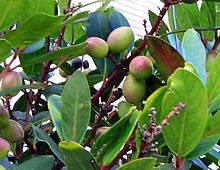Persea
| Persea | ||||||||||||
|---|---|---|---|---|---|---|---|---|---|---|---|---|

Fruiting avocado tree ( Persea americana ) |
||||||||||||
| Systematics | ||||||||||||
|
||||||||||||
| Scientific name | ||||||||||||
| Persea | ||||||||||||
| Mill. |
Persea is a genus of plants withinthe laurel family (Lauraceae). The 150or sospecies are mainly native to the tropical regions of Central and South America , but some species can also be found in Asia . The best-known species are the avocado ( Persea americana ) and the Indian persea ( Persea indica ).
description
Vegetative characteristics
They are evergreen shrubs or medium-sized trees . The thin bark is reddish brown. The alternate, initially hairy, later shiny leathery leaves smell aromatic.
Generative characteristics
The hermaphrodite flowers are yellow and hairy. The bracts are not divided into calyx and crown, so they are tepals . The outer tepals are shorter than the inner ones. There are nine stamens . The ripe fruits are spherical or pear-shaped, deep blue to black berries . The tepals remain at the base of the ripe fruit.
Systematics
The genus Persea was established by Philip Miller in 1754 . A homonym is Persea CFGaertn. ( Supplementum Carpologiae 1805, p. 222). Synonyms for Persea Mill. Are: Machilus Rumph. ex Nees, Mutisiopersea Kosterm., Tamala Raf.
There are about 150 species in the genus. The genus Persea is divided into three subgenus : The Asian subgenus Machilus is considered by many authors as a separate genus Machilus (for example in the Flora of China ). Another closely related genus, Beilschmiedia , is also sometimes incorporated into the genus Persea .

- Subgenus Persea : There are about two species in Central America :
-
Avocado ( Persea americana
Mill. , Syn .: Persea gratissima C.F.Gaertn .; Persea edulis Raf. ) With at least six varieties:
- Persea americana Mill. Var. Americana
- Persea americana var. Drymifolia (Schltdl. & Cham.) SFBlake
- Persea americana var. Floccosa (Mez) Scora
- Persea americana var. Guatemalensis (LOWilliams) Scora
- Persea americana var. Nubigena (LOWilliams) LEKopp
- Persea americana var. Steyermarkii (CKAllen) Scora
- Wild avocado ( Persea schiedeana Nees ): It is distributed from Mexico to Central America to Colombia .
-
Avocado ( Persea americana
Mill. , Syn .: Persea gratissima C.F.Gaertn .; Persea edulis Raf. ) With at least six varieties:
- Subgenus Eriodaphne (Syn .: Mutisiopersea Kosterm. ): The approximately 70 species are native to the Neotropic and Macaronesia :
- Persea alpigena Spreng.
- Persea borbonia (L.) Spreng. : The home is the USA and the Bahamas .
- Persea caerulea (Ruiz & Pav.) Mez (Syn .: Persea skutchii C.K. Allen ): It is widespread in Costa Rica, Honduras, Nicaragua, Panama, Venezuela, Colombia, Bolivia, Ecuador and Peru.
- Persea cinerascens Blake : It occurs in Mexico.
- Persea donnell-smithii Mez : It is distributed from Mexico via Guatemala, Costa Rica, Honduras to Nicaragua.
- Indian Persea ( Persea indica (L.) Spreng. ): The home is the Canaries and Madeira. In the Azores she is a neophyte. (It may belong to a fourth sub-genus of its own)
- Persea lingue (Ruiz & Pav.) Nees : Home is Argentina and Chile; she is a neophyte in Africa.
- Persea longipes (Schltdl.) Meisn. : The home is Mexico and Belize.
- Persea palustris (Raf.) Coffin (Syn .: Persea skutchii C.K. Allen ): The home is the USA and the Bahamas.
- Subgenus Machilus : The approximately 80 species are distributed in Asia :
- Persea ichangensis (Rehder & EHWilson) Kosterm. (Syn .: Machilus ichangensis Rehder & EH Wilson ): It is common in China.
- Persea japonica (Siebold & Zucc.) Kosterm. (Syn .: Machilus japonica Siebold & Zucc. ): It is common in Japan , South Korea and Taiwan.
- Persea macrantha (Nees) Kosterm. (Syn .: Machilus macrantha Nees )
- Persea nanmu olive. (Syn .: Machilus nanmu (Oliv.) Hemsl. ): It occurs in the Chinese provinces of Sichuan and in northeastern Yunnan.
- Persea thunbergii (Siebold & Zucc.) Kosterm. (Syn .: Machilus thunbergii Siebold & Zucc. ): It is common in China, Japan, South Korea and Taiwan.
- Persea yunnanensis (Lecomte) Kosterm. (Syn .: Machilus yunnanensis Lecomte ): It occurs in the Chinese provinces of Sichuan, Yunnan, Guangxi and Tibet.
photos
Illustration of Persea borbonia by Pierre-Joseph Redouté
Fossil leaf: Persea princeps from the Miocene of Öhningen
swell
literature
- Henk van der Werff: Lauraceae : Persea. In: Flora of North America Editorial Committee (Ed.): Flora of North America North of Mexico. Volume 3: Magnoliophyta: Magnoliidae and Hamamelidae. Oxford University Press, New York / Oxford 1997, ISBN 0-19-511246-6 .
- Xi-wen Li, Jie Li, Henk van der Werff: Persea. P. 226. and Machilus. S. 201. In: Wu Zheng-yi, Peter H. Raven, Deyuan Hong (Eds.): Flora of China. Volume 7: Menispermaceae through Capparaceae. Science Press / Missouri Botanical Garden Press, Beijing / St. Louis 2008, ISBN 978-1-930723-81-8 .
Individual evidence
- ↑ Persea at Tropicos.org. Missouri Botanical Garden, St. Louis, accessed October 23, 2015.
- ↑ a b c d e f g h i j Persea in the Germplasm Resources Information Network (GRIN), USDA , ARS , National Genetic Resources Program. National Germplasm Resources Laboratory, Beltsville, Maryland. Retrieved June 11, 2018.
- ↑ a b E. von Raab-Straube (2018): Lauraceae. In: Euro + Med Plantbase - the information resource for Euro-Mediterranean plant diversity. Datasheet Persea




